As evidence, this page is archived as it stood through January 7, 2008.
—Compiled by Torben Jenk
with contributions from Denis Cooke, Ken Milano, Rich Remer, Hal
Schirmer, Dr. Robert Selig & others.
Can further archeology at the site of the proposed
SugarHouse Casino help reveal the location of British
Redoubt [fort] No.1, and/or provide physical evidence of
the line of redoubts which forced Washington to retreat
to Valley Forge for the harsh winter of 1777-1778? Many
remember Christmas 1776, when Washington led his troops
across the Delaware to defeat the Hessians in Trenton,
NJ, but one year later, in 1777, just a few months after
losses in Brandywine and Germantown:
"On
Christmas day Washington
prepared a plan for a surprise attack on the
redoubts north of
Philadelphia. ... The main force approached the line
of [British]
redoubts
and exchanged a few cannon shot without inflicting any
damage. After probing the line of redoubts, Washington
considered the defenses too strong and retired to Valley
Forge." —John W. Jackson, "With the
British Army in Philadelphia 1777-1778" (Presidio, 1979),
pp. 169-170
The
Sugar House Archeology Report (Oct.
2007) by A.D.
Marble & Company does not cite any maps prior to
John Hills (1797)—yet scores of maps, drawings,
surveys, manuscripts and journals survive, providing a
wealth of clues for the Engineers, archeologists,
historians and citizens. Local historians read that
report in early December and immediately noticed the
omission of any Revolutionary War information, or
anything else from the documented history of this area
dating to even before William Penn's arrival in 1682.
On December 12, 2007, an email was sent to the
archeologists raising this concern about Redoubt No. 1
and included a surviving map from 1777, drawn by John
Montresor, Chief Engineer of the British Army in
Philadelphia. The archeologists responded that same
day stating "cannot comment."
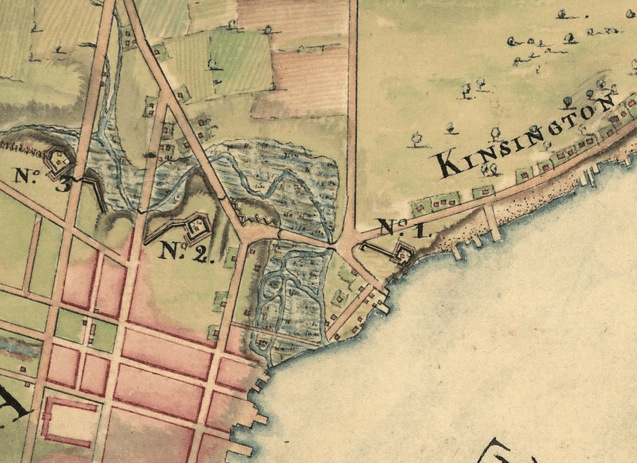
—Detail
showing Redoubt "No. 1" clearly sits on or adjacent to
the SugarHouse property, near the edge of the Delaware
River on a line with Laurel Street (shown as the bridge
over the marsh. Collection: Library of Congress.
The
subsequent SugarHouse Archeology Report (Dec. 28,
2007) states on
page 4
"... it came to A.D. Marble & Company's attention
that a Revolutionary War period fort was potentially
located within the subject property..."
Yet that
report cites NO other documentary evidence about the fort
or the Revolutionary War era—NONE. This webpage
gathers over fifty historical resources revealed by local
historians in just the past few weeks. More are being
added every few days.
Page 5 of the Dec. 28 report states
"We believe no other significant remains from the
fort exist. If any remains could possibly exist, it would
only be the filled in portion of the depression that
likely surrounded the fort. It is our contention that any
remains of any kind would be difficult to interpret
without the existence of the overall resource. No further
action is recommended within the area of the former
Fort."
Archeologists aren't needed if the "overall
resource"—i.e. the entire fort—survived.
Proof exists that Redoubt No. 1 survived for fifty years
after the Revolutionary War, until just before 1830.
Built on a hill, the soils and artifacts were surely
scattered nearby to fill to the bulkhead line or other
depressions.
"The
British redoubts remained til lately—one on the
Delaware bank in a line with the stone-bridge
street—then no houses were near it; now it is all
built up, and streets are run where none were
seen."
—John
F. Watson, "Annals of Philadelphia" (1830), p.
418
As proof that even older items survive even today on the
SugarHouse site, page 3 of the Dec. 28 report
states:
"A small area measuring 50 x 30 feet within the
central portion of Historic Area H-1 was identified as
containing Native American artifacts. This area was
extensively investigated... yielded primarily artifacts
identified as primary and secondary flakes of jasper,
quartz and argillite, probably created during the
manufacture or maintenance of stone tools. Of secondary
frequency was a collection of fire-cracked rock that did
not form any distribution patterns in any of the four
excavation units that would suggest the presence of a
hearth. A broad-bladed, stemmed point was also recovered
within this area."
Finding
Reboubt No. 1 would reveal 18th century British military
engineering, so admired by Major General Charles Lee of
the Continental Army in America, who had bitterly
complained of the incompetence of American engineers,
remarking that "we had
not an officer who knew the difference between a
chevaux-de-frise and a cabbage garden."
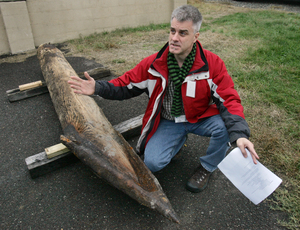
—"Up from the depths of history, a remnant
of the Revolution is pulled from the Delaware" Phila.
Inquirer, Nov. 15, 2007.
Skeptics say "nothing can be found" but in November 2007,
a "cheval-de-frise" was found "in excellent condition"
after more than two centuries in the Delaware River; "it
was probably placed in the river in 1775, at a time when
the Pennsylvania Council of Safety, under the direction
of Benjamin Franklin, was overseeing the colony's
defense." This example survived off Fort Mifflin, despite
the best efforts of the Corps of Engineers to remove them
all in 1946. Documents show that "chevaux-de-frize" and
other items, large and small, were used by the
thousand-plus British and Loyalist soldiers to defend the
redoubts and abatis just north of Philadelphia. Stories
of other archeological finds from disturbed sites in
Philadelphia are on the Philadelphia Archaeological
Forum.
Redoubt No. 1
was built in 1777, just east of the Cohocksink Creek, to
protect the causeway and bridge linking Front Street from
Philadelphia to the main 18th century route between
Philadelphia and New York, known then as the "King's
Highway" or the "Road to Frankfort and N. York"
[Frankford Avenue]. Redoubt No. 1 served as the base and
barracks of the Queen's Rangers under the command of
Lieut. Col. John G. Simcoe, from which they protected
both the crossing of the Cohocksink and that
transportation route to bring food from the Loyalist
farmers in Bucks County to the 60,000 occupants of
Philadelphia.
20th century historians unfamiliar with the massive
changes to the landscape around the long-buried
Cohocksink Creek have mistaken and misplaced its
location, adding to the confusion. In 1701 the Cohocksink
was a navigable creek which powered William Penn's
Governor's Mill but by 1898
it was buried as a sewer. The edge of the Delaware
River has also changed through industrialization
during the 19th century. Local historians have spent
over a decade searching through surveys, deeds, maps,
journals and extant structures to reveal the
long-buried history of this area known as "Point
Pleasant", which prior to the Revolution was also home
to the famed Bachelor's Hall (burned 1776) and
Master's Distillery & Tide Mill, and by 1809
included the Point Pleasant Iron and Brass Foundry
started by Charles Parke to cast bells.
To clarify the inconsistencies of some early maps and
views (especially those produced in England after the
Revolution), relevant quotes are added from various
historic sources including. John F. Watson interviewed
folks who lived through the Revolution for his "Annals of
Philadelphia" and "In
early times, the 'North End' was the common name given to
the Northern Liberties, when having its only road out
Front street. In the present notice it will include the
region of Cohocksinc creek over to Kensington, and
westward over the former Campington. The object is to
bring back to the mind's eye 'its face of nature, ere
banished and estranged' by improvement."
Other captions associated with these various maps,
images, photos and text reveal the contradictions and
complexities—yet hopefully clarify the best of
current research. By sharing these historic resources, we
honor the founding motto of the U.S. Army Corps of
Engineers—"Essayons"
or
"we will try."
After a brief introduction to the area around the
SugarHouse site showing surviving landmarks, scores of
maps, drawings, photos, and words describe the history of
the Cohocksink and Point Pleasant. Where possible, links
are provided to the original sources. A through list of
resources is provided, with links where possible to the
original sources. Further historic material information
is being scanned and prepared. Contributions of relevant
information are welcomed and will be added.
-----
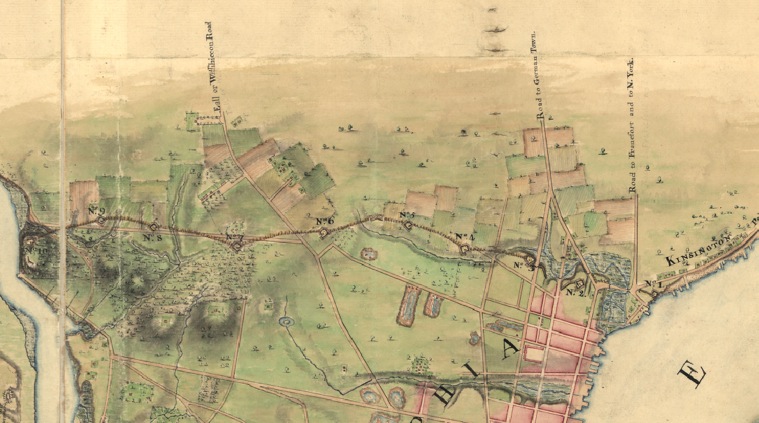
—Detail
from "A survey of the city of
Philadelphia and its environs shewing the several works
constructed by His Majesty's troops, under the command of
Sir William Howe, since their possession of that city
26th. September 1777, comprehending likewise the attacks
against Fort Mifflin on Mud Island, and until it's
reduction, 16th November 1777. Surveyed & drawn by P.
Nicole. Anotated: John Montresor, chief engineer."
Library of Congress
Detail showing
the ten redoubts across the north of Philadelphia, from
"No. 10" along the Schulkyll River atop Fairmount (now
the Art Museum) to "No. 1" along the Delaware River near
the foot of Frankford Road (possibly on the site of the
proposed Sugar House Casino). Front Street is between
Redoubts No. 1 & 2, splitting left to the "Road to
Germantown" (now Germantown Avenue) and right to cross
the marshes of the Cohocksink Creek by causeway and
bridge, connecting to the "Road to Frankfort and to N.
York" (now Frankford Avenue), and through "Kinsington" is
the "Point-No-Point Road" (now Richmond Street) towards
the mouth of the Frankford Creek, about five miles up the
Delaware River.
The "Fall or Wissahiccon Road" (at left) is now Ridge
Avenue. The C-shaped structure east of the "A" in
Philadelphia is the British Barracks, or "Campington",
which stood between Second and Third Streets, near Green
(just above Spring Garden Street). Pegg's Run is the
lower creek which ran along today's Willow Street, just
north of Callowhill Street.
The
northern defense line started by [Chief Engineer]
Montresor in late September [1777] had received very
little attention from the army engineers until after the
batteries on Carpenters' and Province islands were
completed. Work had, however, continued on the redoubts
with civilian laborers being supervised by army officers
and an occasional engineer. ... While Howe was still in
Germantown, it was not considered necessary to man the
fortifications under construction. The five miles between
Philadelphia and Germantown were under constant patrol,
and few American soldiers were to be found in the area.
Rarely, an American patrol came down the Frankford Road,
but always withdrew without challenging the makeshift
British defenses. When the British moved their main army
from Germantown into the City on 19 October [1777],
immediate steps were taken to defend the unfinished
redoubts. Various British and Hessian battalions and
regiments were assigned positions in the rear of the
redoubts. With the
rails and straw transported from Germantown, huts were
constructed to serve as temporary quarters. As materials
were in short supply, every fence within reach was carted
away, and most farmers in the Neck [South Philadelphia]
and near the lines lost their straw. Howe proposed to
quarter the troops in the huts until winter made it
unlikely that Washington would attack and until he could
ascertain where the American army would establish its
winter encampment. Although Howe continued to abhor the
thought of a winter campaign, he was not as certain of
Washington's plans, especially after the surprise attack
on Trenton the previous Christmas. Regardless, it was
evident that the British soldiers could not live in their
huts beyond mid-December—even though Washington's
Continentals would live in similar huts in Valley
Forge. —Jackson, John W.,
With the British Army in Philadelphia 1777-1778
(Presidio, 1979), pp. 95-96
Wonderful descriptions of the activities around Fort No.
1 in 1777 survive, see the:
"First hand accounts of the
activities surrounding the British Redoubts built just
north of Philadelphia,
1777-1778",
"Excerpts from the Journal of Lieut. Col.
John G. Simcoe and the Queen's Rangers in
Revolutionary Kensington" ,
Simcoe's Military Journal
,
The Journals of Capt. John
Montresor,
or this excerpt from "The Manuscript of Colonel Jarvis,
An American's Experience in the British Army"
Fighting
at Germantown under the Colors of the
King
In this day's hard fought action, the Queen's Rangers'
loss in killed and wounded were seventy-five out of two
hundred fifty rank and file which composed our strength
in the morning. Why the army did not the next day pursue
the enemy, and bring them to action, I must leave to
wiser heads than mine, to give a reason, but so it was.
We remained encamped the whole of the next day, and gave
the enemy an opportunity to rally his forces, get
re-inforcements and take tip a position to attack us,
which they did, at Germantown, where our Army had
encamped, sending our sick and wounded into Philadelphia.
At this battle the enemy were again defeated, and left us
in possession of the field. On the morning of this
action, I was under a course of physic, and was ordered
to remain in camp, and had not the honor of sharing in
the victory of this day's battle; I was so reduced from
fatigue that I was returned, unfit for duty, and was
ordered to the Hospital, and the next day took my
quarters at the Hospital in Philadelphia. I was not so
ill but that I could walk about, and the Doctors allowed
me to take a walk about the City every day. Whether they
had any orders from my officers on that behalf I know
not, but so it was when others had not the same
indulgence. I remained in the Hospital until I thought I
was able to undergo the fatigue of duty and join my
Regiment.
A few days after joining the Regiment, made an excurtion
into the Jerseys, as far as Hattenfield, but
it was
ordered that I should remain at the quarters of the
Regiment, which was at Kingsonton.
The next
day Captain Dunlap returned to the quarters ordering
every man that was able to march to join the Regiment,
and myself among the rest. It was near dark when we got
to the Regiment. I was most dreadfully fatigued, and lay
down to rest. I had hardly time to take my refreshment
before the Regiment was ordered under arms, where we
remained for several hours in a storm of hail and snow,
and at last ordered to retrace our steps towards
Philadelphia. I had
marched but a few miles before a pain attacked my limbs,
to that degree, that I could with difficulty walk, and
soon fell in the rear of the Regiment, expecting every
minute to fall into the hands of the enemy. I had the
good luck to get up with the Regiment, who had encamped
at a plantation on the banks of the Delaware. More dead
than alive, the ground covered with snow, I scrambled to
the barn, got into a large mow of straw, covered myself
up with straw, and fell asleep and did not wake until
daylight in the morning. On awaking, I heard Major Simcoe
(who had a short time before, and while I was in the
Hospital) succeeded Major Wymes in the command of the
Regiment, and some of the officers in another part of the
barn, but hid from my sight. They soon left the barn, and
left standing on a beam within my reach a bottle partly
filled with good madeira. I soon demolished the contents
and set the bottle up as before, left the barn also, and
joined my Company. In the course of the day the Americans
attacked us, and we had a smart brush with them, had a
Sergeant (McPherson of the Grenadiers) and several men
wounded. In the evening we crossed over to Kensington and
took up our old quarters.
—The Journal of American History, 1907, p. 450
-----
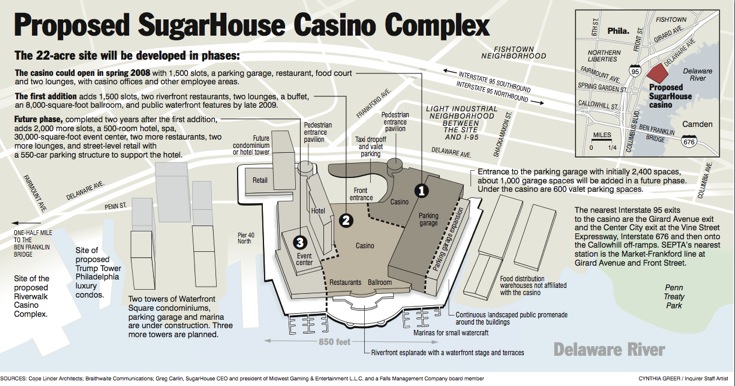
—Drawing from
Philadelphia Inquirer
The ancient path of the Cohocksink Creek is shown under
the "a" in "Casino", between "food" and "court" and then
winds left under much of the text, then empties (not
drawn) into the Delaware River at the "Site of proposed
Trump Tower" where Penn Street and Delaware Avenue
meet. Note how the
22-acre site of the SugarHouse site spreads from
Shackamaxon Street to below Frankford Avenue.
-----
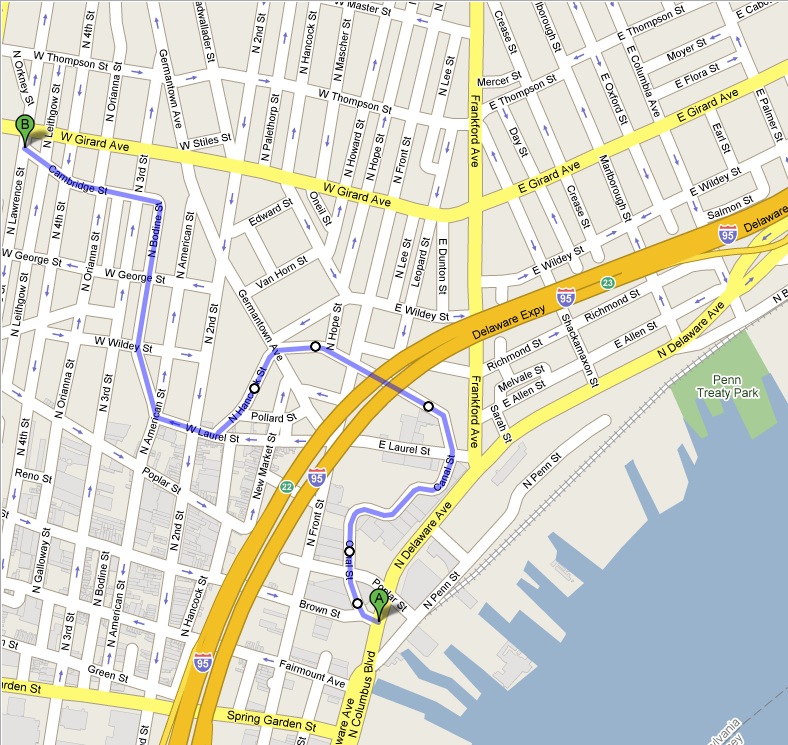
—Map
created on Google Map.
Despite being
turned into a canal and then a sewer, the lower parts of
the Cohocksink are clearly evident under parts of the
streets we know today as Canal, Allen, Hancock, Laurel,
Bodine, Cambridge and Orkney; and in the oddly-shaped
buildings which straddle the creek. Point A is near Pier
35, Point B is where the creek crosses under Girard
Avenue. The Governor's Mill stood
northeast of the ninety degree bend from Cambridge to
Bodine Street. The area below the Frankford Road but
east of the Cohocksink Creek to the Delaware River was
known in Colonial times as "Point Pleasant."
-----
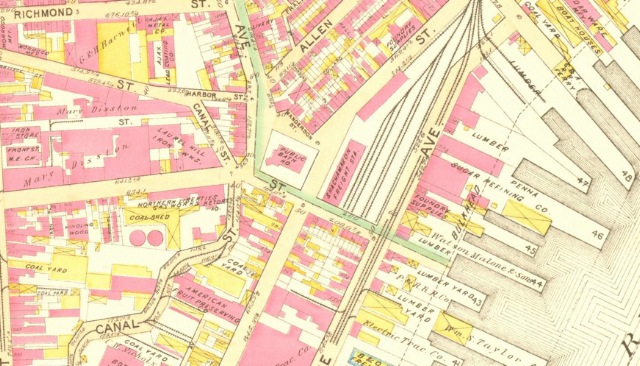
—Detail
from "Atlas of the City of Philadelphia, 1895"
George W. & Walter S. Bromley, Plate
13.
The "Sugar
Refining Co." (see Pier 46) stood on the riverside of
Delaware Avenue, between and below Shackamaxon Street
(above Pier 48) and Frankford Ave (terminating at the
"PUBLIC BATH HO[USE]." Note also the winding "Canal
St."
-----
Robertson
draws the mouth of the Cohocksink in 1777.
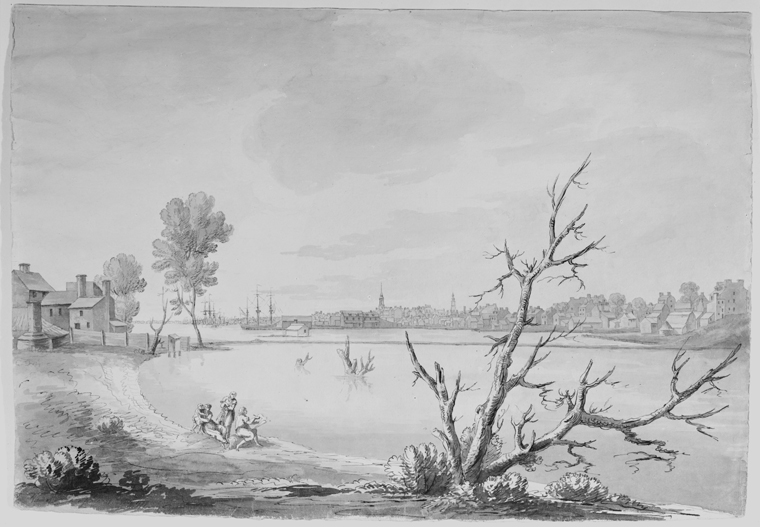
—"View
of Philadelphia." [Lieutenant General Royal Engineers]
Archibald Robertson, November 28, 1777. Drawing in sepia.
38 x 54.3 cm. Source: Spencer Collection, New York Public
Library
Martin P.
Snyder in "City of Independence—Views of
Philadelphia Before 1800" (Praeger, New York, 1975), pp.
115-6, reproduces this drawing and states: "Archibald
Robertson was one of the British engineer officers
participating in the occupation of the city. Two weeks
after the battle of Fort Mifflin had ended with American
withdrawal, he crossed to the New Jersey shore and
rendered in sepia wash a beautiful view of
Philadelphia—seemingly securely British—from
the distance. Its size permitted considerable detail and
its quality is apparent."
This seems incorrect. Robertson's title—"View of
Philadelphia"—is accurate since the City's northern
boundary was then at Vine Street. Robertson's original
drawings and diary survive in the New York Public Library
but were "being conserved" and therefore unavailable for
inspection when I tried to find other substantiating
notes a few years ago. In 1930, the NYPL published the
drawings and diaries in "Archibald Robertson,
Lieutenant-General Royal Engineers: His Diaries and
Sketches in America, 1762-1780 (Harry M. Lydenberg,
Editor).
A crucial clue—ignored by Snyder and
others—is the causeway from the bluffs of Northern
Liberties to Kensington, linking Front Street from
Philadelphia to the beginning of the Frankford Road.
Instead, it seems Robertson was along the northern bank
of the Cohocksink Creek—one of the three characters
drawn in the foreground—looking south to
Philadelphia including the tall steeple of Christ Church
(2nd & Market Streets) and the lower steeple of St.
Peter's (3rd & Pine Streets), southwest to the houses
of Northern Liberties (the bluff being near today's
Second and Poplar Streets), and southeast to "Point
Pleasant," or the beginning of Kensington.The buildings
at the left are likely part of Thomas Masters Distillery
and/or Tide Mill. Thomas Masters had yet another mill,
the Governor's Mill, farther
upstream but also powered by the Cohocksink, where the
liquor store now stands at the southwest corner of
Germantown & Girard Avenues]. The frame structure
in the middle of the water might have been used for
fishing.
In 1739,
Mrs. Mary Smith with her horse were both drowned "near
the long bridge in the Northern Liberties." "Twas
supposed it occured by her horse attempting to drink at
that place where water is very deep." At the same
causeway was quicksand, in which a horse and chair and
man all sunk!—John F.
Watson, "Annals of Philadelphia" (1830), pp.
415-420.
-----
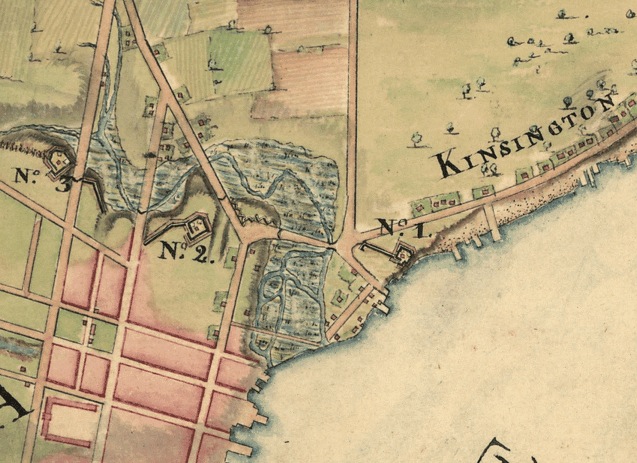
Detail,
mouth of the Cohocksink Creek between Redoubts No. 1
& 3 (1777). Front Street then terminated east of
No. 2 with the "Road to Germantown" heading
northwest. A causeway and bridge crossed east over
the Cohocksink marshes towards No. 1, from which,
heading north is the "Road to Frankfort and to N.
York" (now Frankford Avenue), while heading
east-north-east through "Kinsington" is the
"Point-No-Point Road" (now Richmond Street) towards
the mouth of the Frankford Creek, about five miles
up the Delaware River.
While the
British army occupied Philadelphia, in the year 1777 and
'78, they damned in all the Cohocksinc meadows, so as to
lay them all under water from the river, and thus
produced to themselves a water barrier of defence in
connection with their line of redoubts across the north
end of the city. Their only
road and gate of egress and ingress northward, was at the
head of Front street where it parts to Germantown, and by
Kensington to Frankford. —John
F. Watson, "Annals of Philadelphia"
-----
November
22 [1777] was an eventful day in Philadelphia, starting
with a phenomenon of nature, followed by an act that was
the "Shame the British Nation," and ending with the
joyful news that ships were finally coming through the
river obstructions. At about 7:00 A.M. "a pretty shock of
an earthquake was felt earthquake, probably because they
were distracted by the wanton destruction of many estates
north of the redoubts, between the city and Germantown.
The exact number of homes which were needlessly burned is
not known. Deborah Logan said she saw seventeen fires
from the roof of her mother's house on Chestnut Street;
other eyewitness accounts give varying numbers, but all
deplored the action. Robert Morton's observations best
epitomize the reaction of Loyalists and Americans alike.
“The reason they assign for this destruction of
their friends' property is on acco. [account] of the
Americans firing from these houses and harassing their
Picquets. The generality of mankind being governed by
their interests, it is reasonable to conclude that men
whose property is thus wantonly destroyed under a
pretence of depriving their enemy of a means of annoying
y’m [sic] on their march, will soon be converted
and become their professed enemies. But what is most
astonishing is their burning the furniture in some of
those houses that belonged to friends of government, when
it was in their power to burn them at their leisure. Here
is an instance that Gen'l Washington's Army cannot be
accused of There is not one instance to be produced where
they have wantonly destroyed and burned their friends
property.”
Joseph Reed wrote Thomas Wharton: "The enemy have made at
destruction of the little villas in the neighborhood of
their lines. The bare walls are left; the doors, windows,
roofs and floors are all gone to make huts. Not the least
trace of a fence or fruit tree is to be
seen.”—Jackson, John W.,
With the British Army in Philadelphia 1777-1778
(Presidio, 1979), pp. 104-105
-----
Plan of the English
Lines, Philadelphia 1777.
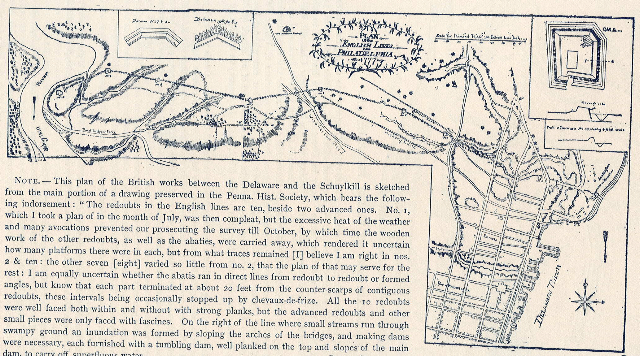
—Scan
of Plan of the English Lines Philadelphia
1777 . Original
source "Narrative and Critical History of
America," Justin Winsor (Editor), (Houghton, Mifflin
& Co., Boston, 1887), Vol VI, p. 440.
[Note, this
eight volume work was expanded to a sixteen volume
work by 1889 and it has been reprinted subsequently.]
The caption reads:
NOTE: This
plan of the British works between the Delaware and
Schuylkill is sketched from the main portion of a drawing
preserved in the Penna. Hist. Society, which bears the
following indorsement: 'The redoubts in the English lines
are ten, besides two advanced ones. No. 1, which I took a
plan of in the month of July, was then compleat, but the
excessive heat of the weather and many avocations
prevented our prosecuting the survey till October, by
which time the wooden work of the other redoubts, as well
as the abaties, were carried away, which rendered it
uncertain how many platforms there were in each, but from
what traces remained [I] believe I am right in nos. 2
& ten; the other seven [eight] varied so little from
no. 2, that the plan of that may serve for the rest; I am
equally uncertain whether the abatis ran in direct lines
from the redoubt to redoubt or formed angles, but know
that each part terminated at about 20 feet from the
counter-scarps of contiguous redoubts, these intervals
being occasionally stopped by chevaux-de-frize. All the
10 redoubts were well faced both within and without with
strong planks, but the advanced redoubts and other small
pieces were only faced with fascines. On the right of the
line where small streams run through swampy ground an
inundation was formed by sloping the arches of the
bridges, and making dams were necessary, each furnished
with a tumbling dam, well planked on the top and slopes
of the main dam to carry off superfluous water.
LEWIS
NICOLA.
Enlarged plans
and cross-sections of redoubts nos, 1, 2, and 10 are
given in the margin, as well as the western advanced
redoubt, and other small works, including the "Barriers
across Kensington and Germantown roads with a
cremaillered work between them cut out of the bank
between the roads." The stars near the lines denote the
places of "houses destroyed by the English." Cf.
description in Penna. Mag. of Histo., iv. 181
-----
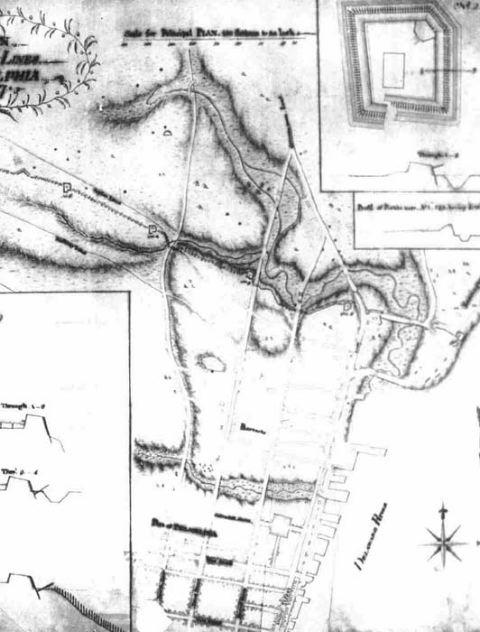
Plan of British Defenses, north side of
Philadelphia, 1778 shows close ups of the riverfront
fort and construction details.
-----
Faden
redraws Montresor, confuses Pegg's Run & Cohocksink
Creek.
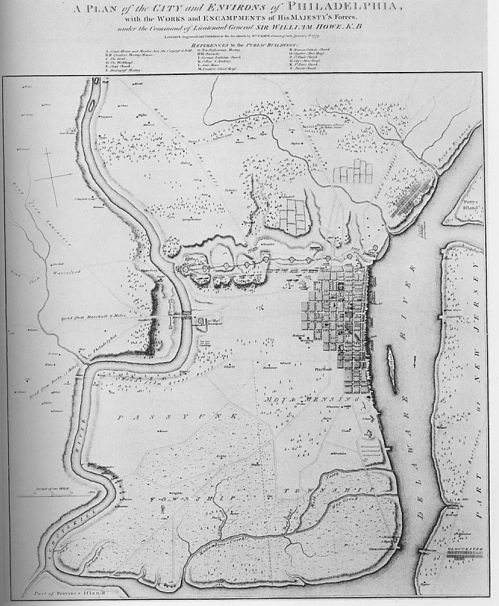
—"A
Plan of the City and Environs of Philadelphia with the
Works and Encampment of His Majesty's Forces...", William
Faden's engraving (1779) and "Atlas of Battles of the
American Revolution" (London, 1793).
William Faden,
engraving this map in London in 1779, confuses Pegg's Run
with the Cohocksink Creek—a mistake clearly visible
when comparing it to Montresor's original below (drawn in
Philadelphia in 1777, now in the collection of the
British Museum), which shows Pegg's Run just north of
Philadelphia with the defenses along the Cohocksink
Creek. —Both
maps copied from Martin P.
Snyder, "City of Independence—Views of Philadelphia
Before 1800" (Praeger, New York, 1975), pp.
116-119.

—Detail, "A Survey
of the City of Philadelphia & it's Environs ... &
the several Batteries & Works constructed thereon,"
John Montresor Chief Engineer, 31-7/8" x 27-3/8",
collection of the British Museum.
-----
Rochambeau's
march, 1781-1782
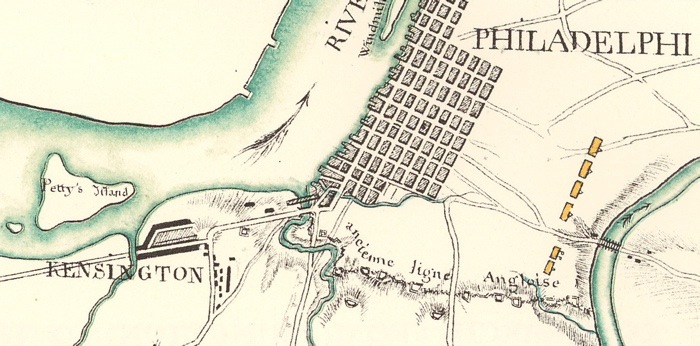
—Detail from
"Read's Lion tavern à Philadelphie" [March from Red Lion
Tavern to Philadelphia], MS, 22 x 33 cm, Princeton
University Library, Bethier Papers, No. 16-4, reproduced
in Howard C. Rice Jr., & Anne S. K. Brown
(translators and editors), "The American Campaigns of
Rochambeau's Army, 1780, 1781, 1782, 1783", (Princeton
University Press, 1972).
3-4 September 1781. "The road bears right a bit but
nevertheless comes closer to the river. On either side of
the road you find woods, county houses, and ruins that
are monuments to the wrath of the English. Half a mile
from the city you see remains of General Howe's lines.
Soon you cross one of the works that the English had
built for the defense of the town. The road turns left,
you cross a brook called Cohocksink Creek, pass through
the suburb of Kensington, and reach
Philadelphia."—"The American Campaigns
of Rochambeau's Army," Vol II, p. 75.
See the "ancienne ligne Anglaise" on the map, described
above as "remains of General Howe's lines." Kensington is
shown at the mouth of the next creek, the Aramingo Creek.
As part of their 625-mile march, over 5,000 troops under
Rochambeau, plus over a thousand animals on hoof and a
similar number of wagons, marched along this route, just
days after Washington and his troops. Rochambeau's troops
camped on the banks of the Schuylkill River (shown by the
yellow boxes), about where 23rd Street is today, between
Race and Locust Streets.
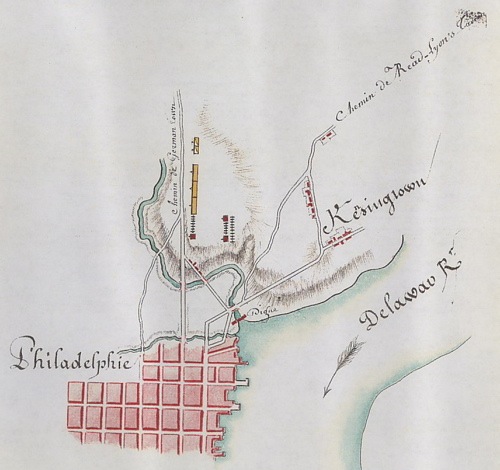
—Detail from
"Twenty-seventh Camp at Philadelphia", MS, 32 x 21 cm,
Princeton University Library, Bethier Papers, No. 39-27,
reproduced in Howard C. Rice Jr., & Anne S. K. Brown
(translators and editors), "The American Campaigns of
Rochambeau's Army, 1780, 1781, 1782, 1783", (Princeton
University Press, 1972).
After the
victory at Yorktown, VA, and the surrender of Cornwallis,
Rochambeau's troops marched north, returning to
Philadelphia on August 31- September 4, 1782.
Rochambeau's troops camped just north of the Cohocksink
Creek, just east of where Second Street and Germantown
Avenue—"Chemin de German Town"—meet (the site
of the recently demolished Schmidt's Brewery). Berthier
shows the main route—"Chemin de Read-Lyons Tavern"
or Road to Red Lion Tavern (fifteen miles north up
Frankford Avenue)— as being the second road after
crossing the Cohocksink.
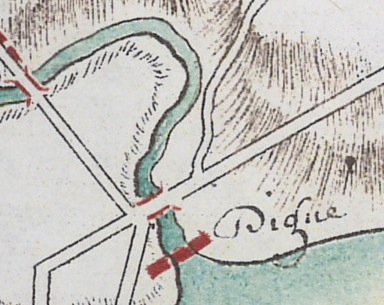
Note the
"Digue" or dike (in red) across the mouth of the
Cohocksink, below the causeway and bridge. Also note
the small mark to the top right of the "e", shaped
rather like a hot air balloon. This seems to be a
distinctive mark, not a splotch or mistake, and
might denote British Redoubt No. 1
-----
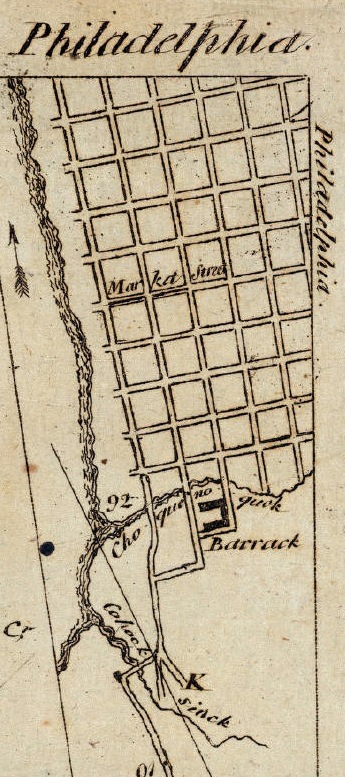
—Detail
"New York to Philadelphia
(1789)", C.
Colles.
The
approach to Philadelphia from New York along Frankford
Road, crossing over the "Cohocksinck Creek" to Front
Street or bend to Second Street. Note the C-shaped
[British] "Barrack" (between today's Second and Third
Streets, Green Street and Fairmount Avenue), and the
"Cho-que-no-quok" or Pegg's Run (today's Willow
Street, just north of Callowhill Street).
-----
"Philadelphia" by Charles P. Varle
(1802).
Two
detailed views from the full map online, c/o David
Rumsey.

Detail showing
the "Entrenchment of the English in the Late War" (dotted
line) and four fortifications (an open square with four
dark squares at the corners) between the Schuylkill River
at Fairmount [Fort No. 10 at the Art Museum] and where
the Cohocksink Creek meets the Delaware River (Reboubt
No. 1 in Kensington).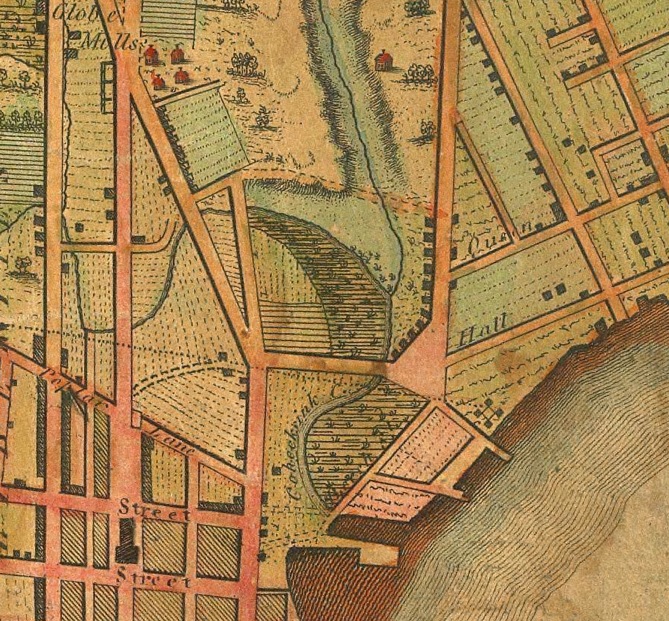
Detail around
Cohocksink Creek, note the extant fortifications (surely
British Reboubt No. 1), between Frankford Road and
Shackamaxon Street, below "Hall" Street. ("Hall" stood
for the infamous "Batchelor's Hall"). Note also the
"Globe Mills" at top left, the former "Governor's Mill" which was
powered by the Cohocksink.
When the
long stone bridge was built, in 1790, (its date is marked
thereon and done by Souders) they came, at the foot of
the foundation, to several curiosities, described to me
by those who saw them, to wit: —a hickory
hand-cuff, perfectly sound—several leaden weights,
for weighing—a quantity of copper farthings, and a
stone hollowed out like a box, and having a lid of the
same.—John F.
Watson, "Annals of Philadelphia" (1830), pp.
415-420.
Formerly
the Delaware made a great inroad upon the land at the
mouth of the Cohocksinc, making there a large and shallow
bay, extending from Point Pleasant down to Warder's long
wharf, near Green Street. It is but about 30 years since
the river came up daily close to the houses on Front and
Coates' street, and at Coates' street the dock there,
made by Budd's wharfed yard, came up to the line of Front
Street. All the area of the bay (then without the present
street east of Front street, and having none of the
wharves now there) was an immense plane of spatterdocks,
nearly out to the end of Warder's wharf, and on a line to
Point Pleasant. The lower end of Coates' street was then
lower then now; and in freshets the river laid across
Front street. All the ten or twelve houses are north of
Coates' street, on the east side, were built on
made-ground, and their little yards were supported with
wharf-logs, and bush-willows as trees. The then mouth of
Cohocksinc was at a wooden drawbridge, then the only
communication to Kensington, which crossed at Leib's
house opposite to Poplar lane; from thence a raised
causeway ran across to Kensington, was not then in
existence. On the outside of this causeway the river
covered, and spatterdocks grew, and on the inside there
was a great extent of marshy ground alternately wet and
dry, with the ebbing and flowing of the tide; the creek
was embanked on the east side. The marsh was probably 200
feet wide where the causeway at the stone bridge now
runs. The branch of this creek which run up to the Globe
mill, [on the place now used as Craig's cotton
manufactory] was formerly deeper than now. Where it
crosses Second street, at the stone bridge north of
Poplar lane, there was in my time a much lower road, and
the river water, in time of freshets, used to overflow
the low lots on each side of it. The houses near the
causeway, and which were there 30 years ago, are now
buried one story underground. The marsh grounds of
Cohocksinc used to afford good shooting for woodcock and
snipe &c. The road beyond, "being Front street
continued," and the bridge thereon, is all made over this
marsh within the last 16 years; also, the road leading
from the stone bridge across Front to Second
street—the hill, to form that road, has been cut
down full 20-25 feet, and was used to fill up the Front
street causeway to the York road, &c. The region of
country to the north of this place and of Globe mill,
over to Fourth street mill-dam, was formerly all in grass
commons, without scarcely a single house or fence
thereon, and was a very great resort for shooting
kill-dear and snipe. It was said the British had burned
up all the former fences, and for many years afterwards
no attempt was made to try and renew them. On these
commons bullbaiting sometimes occured, and many military
trainings. None of the present ropewalks were then there;
but one run where Poplar lane now lies, from Front to
Second street—that not having been a street til
within 25 years ago. The British redoubts remained til
lately—one on the Delaware bank in a line with the
stone-bridge street—then no houses were near it;
now it is all built up, and streets are run where none
were seen. The next redoubt, west, stood in an open grass
lot of Captain Potts, on Second street and in front of
where St. John's Methodist church now stands.—[John
street was not then run there.] Another redoubt stood on
Poplar lane and corner of Fifth street,—another
back of Bush Hill house, and another was on Fair
Mount,—another on the hill south of High street,
where the waterworks were located. All the Cohocksinc
marsh is now filled up and built upon, and an imense long
wharf and a bridge from it is made to join a street to
Kensington.—John F.
Watson, "Annals of Philadelphia" (1830), pp.
415-420.
-----
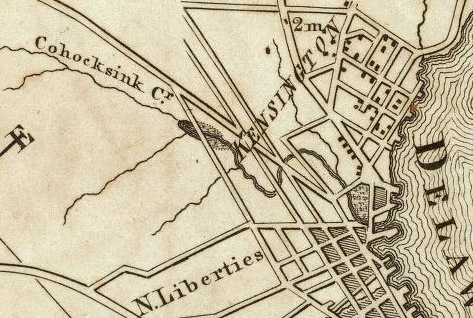
—Detail,
"Philadelphia and the commencement of the
road to New York", S.S. Moore & T.W.Jones
(1802)
-----
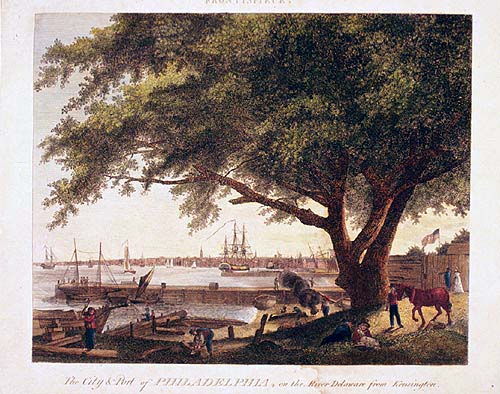
Painted
in 1800, and supposedly true to life, could the wooden
structure to the right of the famed Treaty Tree (flying
the flag) be the surviving British Redoubt
No.1?
-----
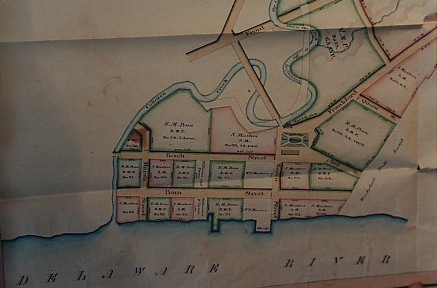
—Detail "Camac
Family Estate Papers,1802-1860" HSP, Call # A39, 4V,
Collection 1420.
Starting in
the early 1700s, the Masters Family purchased about 1,200
acres north of the Cohocksink Creek, including Point
Pleasant. By the early 1800s, the heiresses were Sarah
Masters (the wife of Turner Camac) and Mary Masters (the
wife of Richard Penn, William's grandson). This
watercolor map shows the division of property between
them, with the lots shown as "S. Masters / S. M." and "R.
M. Penn / R. M. P."
Since other maps suggest that British Redoubt No. 1 was
located within the area enclosed by Beach / Hall Street,
Maiden Lane and the Delaware River, a close examination
of the deeds in that small area might reveal a
description and location of British Redoubt No. 1. The
first crossing over the Cohocksink Creek from Northern
Liberties to Kensington was by the causeway and stone
bridge (now Laurel Street). Later, perhaps atop the dike,
a second crossing appeared with a wood
draw-bridge.
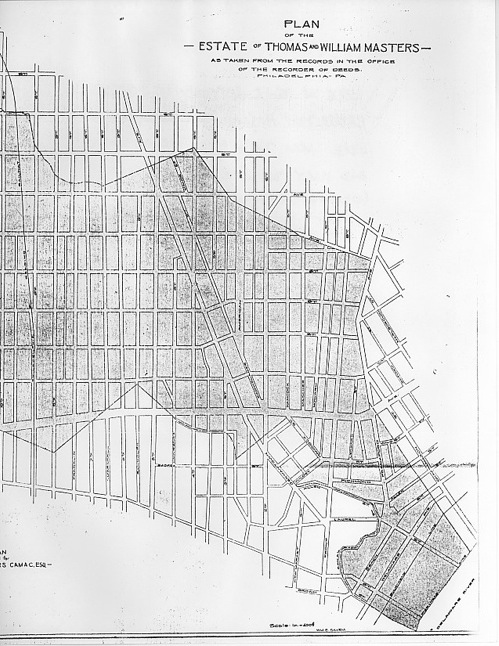
—"Plan of the
Estate of Thomas and William Masters as taken from
the records in the office of the Recorder of Deeds,
Philadelphia."
-----
THE
COHOCKSINK CREEK AND POINT PLEASANT BEFORE 1777.
Surveys and
disputes over property boundaries provide many clues to
the ancient paths of the winding Cohocksink Creek, the
edge of the Delaware River, plus the newly laid-out roads
and buildings around 1730. The Logan Papers at HSP are a
superb resource with over forty surveys and
descriptions. Early deeds
and lawsuits provide additional evidence to help locate
the exact sites of demolished Colonial-era
structures.
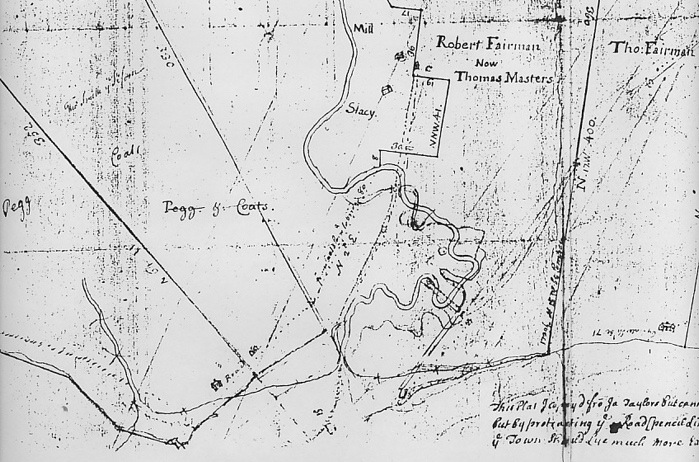
—Partition
of Lands among Fairman Heirs, c. 1714.
Front Street
crosses Pegg's Run before terminating south of the
Cohocksink, where the road to Germantown Road leads up to
Stacy's field and the Mill. John Watson provides superb
details in his "Annals of Philadelphia" (1830), pp.
415-420.
The whole
region was originally patented to Jurian Hartsfelder, in
1676 by Governor Andros of New York government. In ten
years afterwards he sold out to D. Pegg his whole 350
acres, extending from Cohocksinc creek, his northern
line, to Pegg's run, his southern line. That part beyond
Cohocksinc, northward, which came under Penn's patent,
was bought, in 1718, by J. Dickinson—say 945
acres—at 26s. 8d. sterling, and extending from the
present Fairhill estate over to Bush Hill. Part of the
same estate has been known in more modern times as
"Master' estate and farm," and some of it is now in
possession of Turner Camac, Esq. who married Masters'
daughter.
The primitive state of the North End near the Cohocksinc
creek, is expressed in a petition, of the year 1701, of
the country inhabitants (115 in number) of Germantown,
Abington, & c. praying the Governor and Council for a
settled road into the city, and alleging that "they have
lately been obliged to go round new fences, from time to
time set up in the road by Daniel Pegg and Thomas
Sison,"* [* This name was spelt Tison in another place]
for that as they cleared their land, they drove the
travellers out into uneven roads and very dangerous for
carts to pass upon. They therefore pray "a road may be
laid out from the corner of Sison's fence straight over
the creek [meaning the Cohocksinc, and also called
Stacey's creek] to the corner of John Stacey's field, and
afterwards to divide into two branches—one to
Germantown and one to Frankford." They add also that
Germantown road is most travelled—taking thereby
much lime and meal from three mills, with much malt, and
a great deal of wood, timber, &c. At the same time
they notice the site of the present "long stone bridge
and causeway over to Kensington, by saying "they had
measured the road that is called the Frankford road, over
the bridge from about the then part of the tobacco field,
to a broad stone upon Thomas Sison's hill near his fence,
and find it to be 380 perches, and thence to the lower
corner of John Stacey's field to the aforesaid tobacco
field 372 perches, beside (along) the meadow and creeek
by John Stacey's field, and of the latter we had the
disadvantage of the woods, having no line to go by, and
finding a good road all the way and very good fast
lands." I infer from this petition (now in the Logan
collection) that they desired the discontinuance of the
then road over the long bridge to Frankford,** [** It is
possible, however, that the long bridge may have been one
on piles, directly out Front street as it now runs - as
such piles were there in my youth, and a narrow causeway.
It was either the remains of old time, or it had been
made by the British army as they flooded that land.] and
that both Germantown and Frankford roads should diverge
"by as near a road, having fast land all
along."
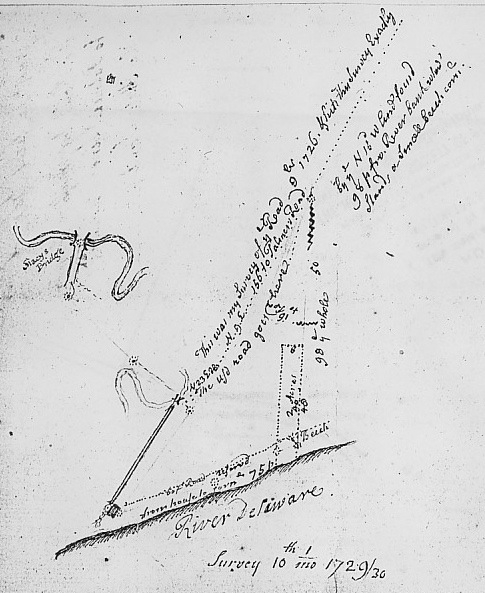
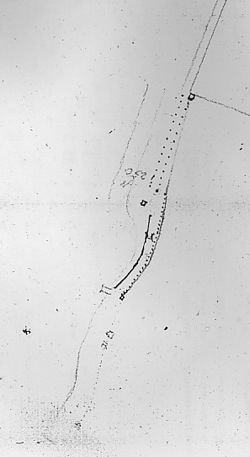
—Survey
10th mo. 1729/30, "I suppose a small part of Frankford
Road near the Bridge... This was my survey of Ye.
Road..." [to Frankford]
—Survey March 10, 1729/30, "[?] to flat part of the
Road by Masters Tide Mill to Palmer's Line including the
Hall Land." [Masters Tide Mill is likely the square
structure near the river]. Source: HSP, Logan's Papers,
Vol 13:41
A letter
of Robert Fairman's, of the 30th of 8 mo. 1711, to
Jonathan Dickinson, speaks of his having a portion of the
13 acres of his land next the Coxon creek (Cohocksinc)
and in Shackamaxo.*** [*** Thus determining, as I
presume, that Shackamaxon began at Cohocksinc creek, and
went up to Gunner's creek.] In another letter of the 12th
of 3 mo. 1715, he says "the old road and the bridge to it
being so decayed and dangerous for passengers, my brother
Thomas, with Thomas Masters, and others thought it proper
to move your court for a new road, which being granted, a
new bridge was made and the road laid out, and timber for
the bridge was cut from my planatation next the creek;
but not being finished before my brother Thomas died, has
since been laid aside and the old bridge and road are
repaired and used—thus cutting through that land of
mine and his, so as to leave it common and open to
cattle, & c. notwithstanding the new road would have
been a better route. This has proceeded from the malice
of some who were piqued at my
brother."
In the
year 1713, the Grand Jury, upon an inspection of the
state of the causeway and bridge over the Cohocksinc, on
the road leading to the "Governor's mill"—where is
now Craig's manufactory—recommend that a tax of one
pence per pound be laid "to repair the road at the new
bridge by the Governor's mill, and for other purposes."
In 1739 the said mill took fire and was burnt down. It
was thought it occured from the wadding of guns fired at
wild pigeons.
This mill seems to have been all along an ill adventure;
for James Logan, in 1702, speaking of the Governor's two
mills, says, "those unhappy expensive mills have costs
since his departure upwards of 200 in dry money. They
both go these ten days. The "Town Mill," (now Craig's
place) after throwing away 150£. upon her, does exceeding
well, and of a small one is equal to any in the
province."
Old Mr. Wager (the father of the present Wagers) and
Major Kisell have both declared, that as much as 60-65
years ago they had seen small vessels with falling masts
go up the Cohocksinc creek with grain, to the Globe
mill—the same befoe called the Governor's mill. Old
Captain Potts, who lived near there, told me the same
thing when I was a boy. —John F.
Watson, "Annals of Philadelphia" (1830), pp.
415-420.
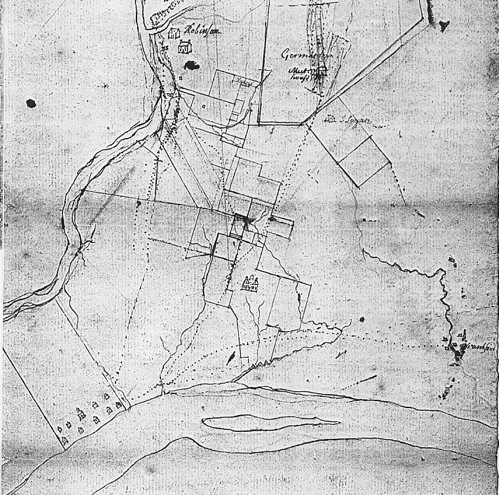
—Detail of survey c.
1729 showing Fairhill. —Source: HSP, Logan's
Papers, Vol 13:41
The Fairhill
estate of Isaac Norris was over 800 acres, from the north
bank of the Aramingo Creek towards the "mansion" [shown
near the center of the image and below] which stood near
today's 6th & York Streets. Philadelphia is the
rectangle to the left with ten houses along the Delaware
River. Pegg's Run is just north of the city line. Dotted
lines signify Front Street, splitting at the Cohocksink
Creek towards Germantown and Frankford [shown at right].
Ridge Avenue heads towards the mouth of the Wissahickon
and the "Robinson" mill [at top].
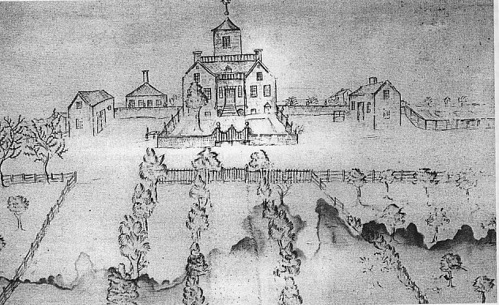
A superb, extensive and
illustrated description of "Isaac Norris's Fairhill" by
Mark Reinberger and Elizabeth McLean was published in
Winterthur Portfolio, Vol. 32, No. 4, Winter 1997, pp.
243-274.
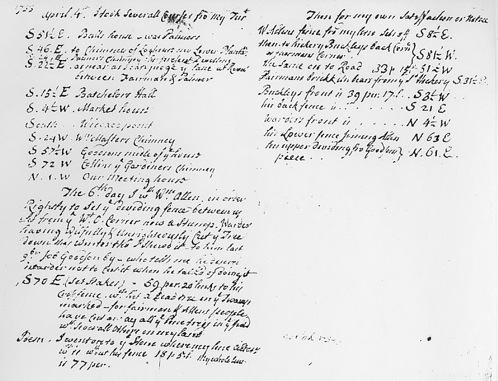
"1733, April 4th, I took
severall courses from my Tur" [turret atop
Fairhill].—Source: HSP,
Logan's Papers, Vol 13:48½
From his roof,
the learned Isaac Norris took directions to surrounding
landmarks:
S 51½ E. Balls house - was Palmers [also known as
Richmond Hall, between the Aramingo Creek and the
Delaware River. Palmer sold this in 1729 and bought 191½
acres from the Fairman estate to found "Kensington"]
S 24 E. Palmers Chimney [?] the present dwelling or near
as I can ...
S 15½ E. Batchelor's Hall [which stood near the foot of
Shackamaxon Street near the Delaware River].
S 4½ E. Market House [likely Second and Market Streets,
Philadelphia].
S 24 W. Wm. Masters Chimney
...
-----
The
Cohocksink Creek as canal and sewer.
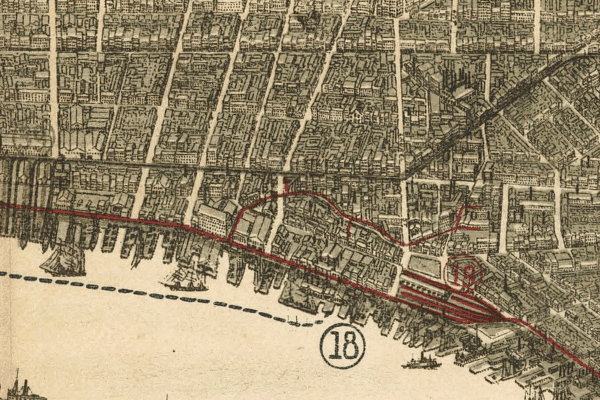
—Detail from
birds eye view, "Philadelphia in
1888", Burk &
McFetridge (source: Library of
Congress)
The beginning
of the Cohocksink Canal can be seen as the winding red
line. Sugar House sits on the riverside of the parallel
red train tracks, under the red #19.
-----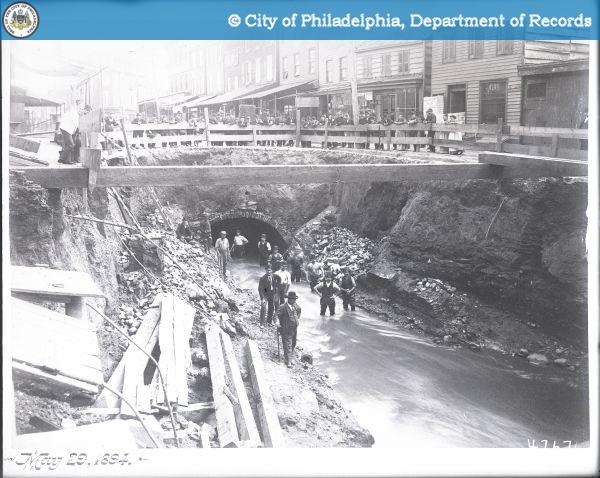
—Break In Cohocksink Sewer - Germantown
Avenue Above 2nd Street [below
Girard].
Construction Of Cohocksink Sewer. (May 29, 1894).
Source: Philadelphia Archives /
PhillyHistory.org
Inspectors from the Philadelphia Water Department say the
Cohocksink Sewer below Girard Avenue approaches twelve
feet in diameter, which seems close to accurate from this
photo.
-----
RESOURCES
(books, manuscripts, maps, surveys,
texts)
BOOKS
William
Howe, "The Narrative of Lieut. Gen. Sir William Howe...
(Baldwin, London, 1780), pp. 54-55.
John
W. Jackson, "With the British Army in Philadelphia
1777-1778" (Presidio, 1979).
Philip Chadwick Foster Smith, "Philadelphia on the River"
(Philadelphia Maritime Museum, 1986).
David Breckenridge Read, "The Life and Times of Gen. John Graves
Simcoe, Commander of the 'Queen's Rangers' during the
Revolutionary War, and first Governor of Upper
Canada" (George
Virtue, Toronto, 1890).
Harry M.
Lydenberg, Editor, "Archibald
Robertson, Lt. General, Royal Engineers: His Diaries and
Sketches in America, 1762-1780," (New
York, 1930) [Robertson's original drawings and diary are
in the Spencer Collection of the New York Public
Library].
G.D. Scull, editor, The Journals of Capt. John
Montresor from the
original manuscript in the possession of the Montresor
family (Collections of the New York Historical
Society, 1881).
Lieutenant-Colonel John Graves Simcoe, "A Journal of the
operations of the Queens Rangers, from the end of the
Year 1777 to the Conclusion of the late American War"
(Exeter, printed for the author, 1782?).
Lieutenant-Colonel John Graves Simcoe,
"Military Journal—A History of the
Partisan Corps called the Queens Rangers, Commanded b
y Lieut. Col. J.G. Simcoe, during the War of the
American Revolution", (New
York, 1844).
"Excerpts from the Journal of Lieut. Col.
John G. Simcoe and the Queen's Rangers in
Revolutionary Kensington"
Frank E. Snyder & Brian H. Gus, "The District, A
History of the Philadelphia District U.S. Army Corps of
Engineers, 1866-1971 (U.S. Army Engineer District,
Philadelphia, 1971), pp. 106-115 & pp. 156-157.
Martin P. Snyder, "City of Independence—Views of
Philadelphia Before 1800" (Praeger, New York, 1975).
Frank H. Taylor, "Valley Forge, A Chronicle of American
Heroism" (Nagle,
1905, 1911, +), see items "The British Army in
Philadelphia" &
"Country Seats
Destroyed."
Russell F. Weigley (Editor), "Philadelphia, A 300-Year
History" (Norton, New York, 1982), especially pp. 138-139
with related footnotes. "The whole tedious business of
gaining control of the Delaware left the British army
feeling far less at ease in Philadelphia than they had
anticipated. To ward off another attack by Washington,
Howe erected a chain of ten redoubts, with connecting
abatis, between the iwo rivers in a line running of and
parallel to Callowhill Street. The construction of these
works, begun while Howe was still in Germantown, was
hampered by a labor shortage. Although Joseph Galloway
was sure it would be a simple matter to get 500 civilians
to do the digging, the most the British could obtain was
about eighty. Few were interested in working all day for
eight pence and a ration of salt provisions. Many summer
mansions that might have sheltered snipers along
the defense line were burned to the ground, including
John Dickinson's Fair Hill, formerly a residence of his
father-in-law Isaac Norris II."
Edwin Wolf, 2nd, "Philadelphia, Portrait of an American
City" (Stackpole, Harrisburg, PA, 1975).
MAPS
showing the area around Point Pleasant, including the
defenses built by the British in 1777 to defend
Philadelphia.
 — "A survey of the city of Philadelphia and
its environs shewing the several works constructed by
His Majesty's troops, under the command of Sir William
Howe, since their possession of that city 26th.
September 1777, comprehending likewise the attacks
against Fort Mifflin on Mud Island, and until it's
reduction, 16th November 1777. Surveyed & drawn by
P. Nicole. Anotated: John Montresor, chief
engineer." Collection:
Library of Congress.
— "A survey of the city of Philadelphia and
its environs shewing the several works constructed by
His Majesty's troops, under the command of Sir William
Howe, since their possession of that city 26th.
September 1777, comprehending likewise the attacks
against Fort Mifflin on Mud Island, and until it's
reduction, 16th November 1777. Surveyed & drawn by
P. Nicole. Anotated: John Montresor, chief
engineer." Collection:
Library of Congress.
 — A Survey
of the City of Philadelphia & it's Environs
comprehending the Neck formed by the Rivers of
Delaware & Schuylkill; together with Province,
Carpenters, & Mud Islands, & the several
Batteries & Works constructed thereon.
Philadelphia 15th Dec. 1777, John Montresor Chief
Engineer, 31-7/8" x 27-3/8", at the British Museum.
[Reproduced in Martin P. Snyder, "City of
Independence—Views of Philadelphia Before
1800" (Praeger, New York, 1975), pp. 116-119.]
— A Survey
of the City of Philadelphia & it's Environs
comprehending the Neck formed by the Rivers of
Delaware & Schuylkill; together with Province,
Carpenters, & Mud Islands, & the several
Batteries & Works constructed thereon.
Philadelphia 15th Dec. 1777, John Montresor Chief
Engineer, 31-7/8" x 27-3/8", at the British Museum.
[Reproduced in Martin P. Snyder, "City of
Independence—Views of Philadelphia Before
1800" (Praeger, New York, 1975), pp. 116-119.]
To His Excellency, Sir Henry Clinton K. B. General and
Commander in Chief of his Majesty's Forces, within the
Colonies laying on the Atlantic Ocean from Nova Scotia to
West Florida inclusive &c. &c. &c. John
Montresor Chief Engineer, 26-1/4" x 38-3/4", at the
University of Michigan William L. Clements Library,
Clinton Papers, described in Randolph G. Adams, British
Headquarters Maps and Sketches (Ann Arbor, Mich., 1928),
pp. 77-78.
Untitled plan of Philadelphia, 35-1/4" x 27-3/4, at the
William L. Clements Library, described in above, p. 77.
Untitled plan of roads leading out of the city, 12-1/2" x
15-3/4", at Library of Congress, described in P. Lee
Phillips, A Descriptive List of Maps and Views of
Philadelphia in the Library of Congress, no. 170.
Plans of British Army positions within present-day
Philadelphia, by John Andre, at the Huntington Library,
San Marino, California, reproduced in
Henry Cabot Lodge, ed., "Major Andre's Journal" (Boston,
1903), I:124, 128, 132, 134.
Untitled plan of a British camp on the Schuylkill River,
by Sir Henry Clinton, at the William L. Clements Library,
described in Randolph G. Adams, British Headquarters Maps
and Sketches (Ann Arbor, Mich., 1928), p. 78.
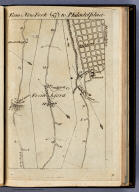 — From New York To Philadelphia
(1789),
Christopher Colles
— From New York To Philadelphia
(1789),
Christopher Colles
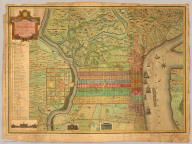 —Charles P. Varle, Philadelphia
(1802). "To The
Citizens Of Philadelphia This New Plan Of The City And
Its Environs Is respectfully dedicated By the Editor.
1802. P.C. Varle Geographer & Enginr. "A
beautiful, early map of Philadelphia in full period
color. The scale is given at 75 Perches to 1 inch. The
city is shown from the Delaware River to the Schuylkil
River with the environs on the north and south. 24
lettered references and 28 numbered references to
important places and buildings are below the title and
24 wards are keyed in Roman numbers above the title.
Many of the country houses and farms around the city
are named, including Penn, Dr. Wistar, and other
notable early residents. Three inset views show City
Hall, the State House, Court House, Library, and Bank
of the United States. The tile is surrounded by a
decorative cartouche. The quality of the engraving is
superb. Ristow mentions an undated edition that was
possibly issued in the year Varle made the surveys,
1796, but more likely in 1802. Wheat and Brun list a
c.1794 State I that has one less numbered building
reference, no Roman numbered ward references, and ""R.
Scott Sculp. Philadelphia."" This was Varle's first
map published in the United States. Until 1807, Varle
was known as Peter C. Varle; after 1807 he is known as
Charles P. Varle." —davidrumsey.com
—Charles P. Varle, Philadelphia
(1802). "To The
Citizens Of Philadelphia This New Plan Of The City And
Its Environs Is respectfully dedicated By the Editor.
1802. P.C. Varle Geographer & Enginr. "A
beautiful, early map of Philadelphia in full period
color. The scale is given at 75 Perches to 1 inch. The
city is shown from the Delaware River to the Schuylkil
River with the environs on the north and south. 24
lettered references and 28 numbered references to
important places and buildings are below the title and
24 wards are keyed in Roman numbers above the title.
Many of the country houses and farms around the city
are named, including Penn, Dr. Wistar, and other
notable early residents. Three inset views show City
Hall, the State House, Court House, Library, and Bank
of the United States. The tile is surrounded by a
decorative cartouche. The quality of the engraving is
superb. Ristow mentions an undated edition that was
possibly issued in the year Varle made the surveys,
1796, but more likely in 1802. Wheat and Brun list a
c.1794 State I that has one less numbered building
reference, no Roman numbered ward references, and ""R.
Scott Sculp. Philadelphia."" This was Varle's first
map published in the United States. Until 1807, Varle
was known as Peter C. Varle; after 1807 he is known as
Charles P. Varle." —davidrumsey.com
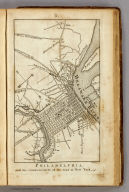 — Philadelphia and the commencement of the
road to New York (1802), S.S. Moore & T.W.
Jones
— Philadelphia and the commencement of the
road to New York (1802), S.S. Moore & T.W.
Jones